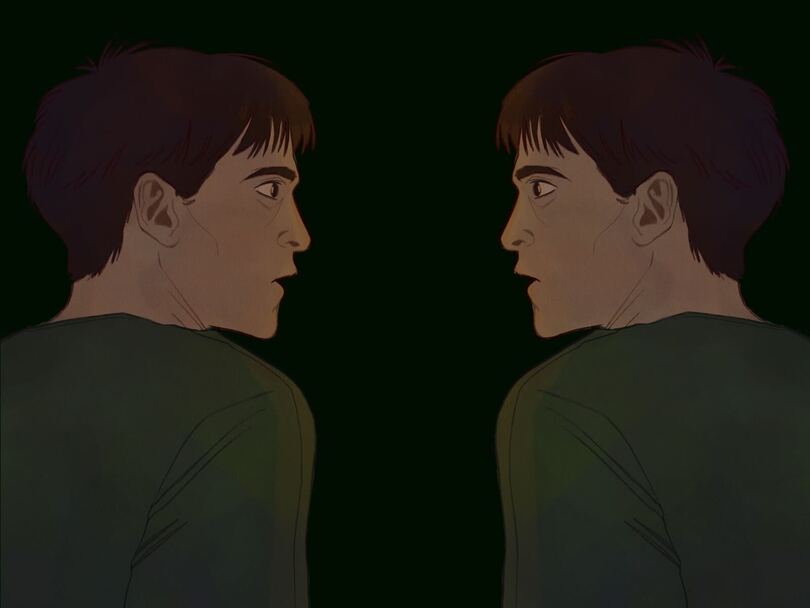‘Mickey 17’ explores class divide, power within intergalactic backdrop

Bong Joon Ho’s “Mickey 17” follows the character Mickey Barnes, played by Robert Pattinson. The film explores themes of class divide and social tensions through a science fiction story. Madison Denis | Contributing Illustrator
Get the latest Syracuse news delivered right to your inbox.
Subscribe to our newsletter here.
Bong Joon Ho’s notoriety in Hollywood exploded on Feb. 9, 2020. He won the Best Director Oscar for his film “Parasite,” which also won Best Picture — the first foreign language film to win Hollywood’s biggest prize. After over 30 years as a feature film director, he finally reached the mountaintop.
Fans all around the world anticipated his next move. Five years later, their questions are answered.
“Mickey 17” is Bong’s largest and most outlandish project to date. Its sense of humor and pace are unlike those of his prior work. The science fiction genre allows Bong to take creative risks, and it’s fascinating to watch a director of his caliber play in that sandbox. While the film does have some storytelling challenges, Bong’s ability to keep the tone and charm consistent with his commentary on class makes “Mickey 17” a compelling and entertaining watch.
In “Parasite,” Bong examined the stark class divide and the potential for exploitation and violence it creates, ultimately questioning the nature of the rich and the poor. “Mickey 17” takes these ideas and places them against an intergalactic backdrop.
Based on Edward Ashton’s 2021 novel “Mickey 7,” the film “Mickey 17” follows Mickey Barnes (Robert Pattinson), who joins a group of people looking to colonize an alien planet called Niflheim in the year 2054. He volunteers to become an “expendable,” a person who’s set up to be killed and cloned over and over to help scientists better prepare humanity to survive in the new world.
When Mickey is accidentally cloned without dying, the two Mickeys must work together to overthrow Kenneth Marshall (Mark Ruffalo), a disgraced politician who starts the expedition to Niflheim in an attempt to become its dictator.
Nearly all of Bong’s films revolve around social issues, and “Mickey 17” is no exception. Marshall leads the expedition from Earth to Niflheim, a journey that takes four and a half years. On the ship, he divides the higher-class leaders of the new world and the lower-class people who will work on the planet. As an expendable, Mickey is the lowest on the totem pole.
Pattinson seamlessly balances the levels of craziness and humanity needed to keep the film moving. In the beginning, Mickey is naive and finds levity in repeated death. As the film progresses and a more serious 18th clone of Mickey emerges, Mickey 17 becomes radicalized against Marshall and realizes he can’t allow him to take over Niflheim. Pattinson’s voice in the film has received plenty of critiques, but the high-pitched tone works well for the character.
Because he dies over and over again, Mickey struggles to form relationships with anyone else on the ship besides Nasha Barridge (Naomi Ackie) and Timo (Steven Yuen). These characters help keep Mickey grounded and offer the audience a closer look at the societal rift Marshall has created on the ship.
To preserve resources, Marshall limits the amount of calories people are allowed to eat and burn daily. The lower class can only eat certain foods and aren’t allowed to perform certain activities that might push them physically. Barridge and Mickey 17 form an intense sexual relationship, but must keep it a secret as Marshall banned sex on the ship. Meanwhile, Timo starts dealing oxycodone drugs to other passengers.
Many people who joined Marshall on the trip to Niflheim seek a new lease on life in a society they can forge for themselves. But humans won’t be the dominant species on the new planet. Niflheim is home to an alien race, which Marshall refers to as “creepers.” In an interview with Entertainment Weekly, Bong said he created three types of creepers — the mamas, the juniors and the babies — and based the creatures’ design on croissants.
Their design is both scary and charming. Although they’re dangerous to humans, they never feel like a massive threat. Still, Marshall intends to wipe them out and take complete control of the planet, rather than coexist with them.
Bong said Marshall is a caricature of several different dictators. He’s incredibly powerful, yet hilariously incompetent. Most of his decisions are made at the behest of his wife, Ylfa (Toni Collette), who has even less respect for the lower class of the ship than Marshall.
Marshall and Ylfa see Niflheim as a chance to gain power, while Mickey 17, Timo and the rest of the lower class seek new opportunities. After spending four and a half years living as lower-class citizens, it’s unsurprising that the crowd has turned on Marshall and sees Niflheim for what it is.
Similar to his 2013 film “Snowpiercer,” Bong uses a world-changing event as a backdrop to examine how humanity evolves and devolves. He shows how if humans are pressed beyond their natural limits, their societies will eventually crumble.
In “Mickey 17,” the journey to Niflheim has divided those who still believe in Marshall’s vision and those who don’t. Regardless, Marshall remains committed to colonizing Niflheim and making it his own, no matter what damage may occur.
The most oppressed characters in the story are the creepers, whose home world is being invaded. Marshall doesn’t want to coexist because he thinks they’re dangerous, solely due to their appearance. It takes Nasha and the Mickeys, members of the lower class, to lead a rebellion against Marshall and save the species from annihilation.
Bong’s ability to dissect human behavior amid class struggle makes his filmography compelling. After the success of “Parasite,” it’s only fitting that he took his ideas to the unknown of outer space. “Mickey 17” is an excellent continuation of his sensibilities as a director, only adding more intrigue to what the rest of his career will bring.






